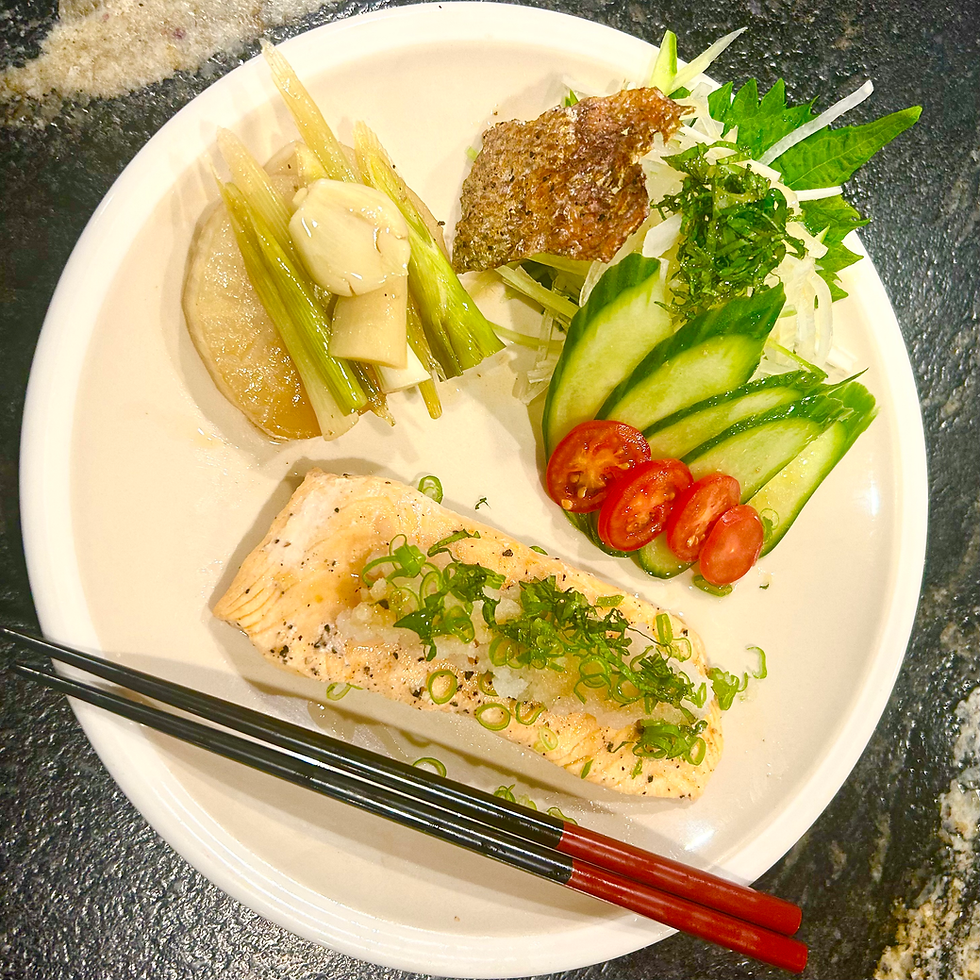Low-Sodium Salmon Nimono with Daikon–Cucumber Salad
- Akihiro Shimo
- Jul 24
- 3 min read
Updated: Aug 20
A clean and elegant Japanese-inspired dish that uses simmering techniques and aromatics to develop deep flavor—without relying on sodium. This recipe pairs gently poached salmon with a simple daikon-cucumber-tomato salad dressed in wasabi vinaigrette, offering a satisfying and beautifully balanced plate.
Servings: 1
Prep Time: 10 minutes
Cook Time: 15 minutes
Ingredients
Main
1 salmon fillet (~4–6 oz), skin-on
1-inch slice daikon (for simmering)
1 clove garlic, lightly crushed
1-inch knob fresh ginger, sliced
1/2 stalk green onion, cut in half
Optional: salmon skin, crisped separately
Freshly ground black pepper (to taste)
Nimono Sauce (Low-Sodium Simmering Broth)
Step 1 – Base Mixture
1 Tbsp low-sodium soy sauce
1 Tbsp allulose
10x volume in homemade dashi)
Step 2 – Simmering Blend (for use)
2 Tbsp of the base mixture
3 Tbsp dashi
1 Tbsp water
Mini Salad
1/4 cup daikon and cucumber, julienned
1/3 cucumber, thinly sliced
2–3 mini tomatoes, halved
1 shiso leaf, finely sliced (optional)
Wasabi vinaigrette (light drizzle, to taste)
Garnish
Grated daikon (daikon oroshi)
Finely sliced green onion
Shiso chiffonade (optional)
Instructions
Prepare the Simmering Broth
Combine soy sauce, allulose, and 10x dashi to make the base. Measure 2 Tbsp of this and mix with 3 Tbsp dashi and 1 Tbsp water for the final simmering liquid.
Simmer the Aromatics
In a small pan, add daikon slice, garlic, ginger, and green onion. Pour in the prepared simmering liquid and bring to a low simmer.
Cook the Salmon
Lightly season salmon with pepper. Place skin-side down into the pan. Cover with a lid or parchment drop-lid (otoshibuta). Simmer gently for 6–8 minutes, turning once if desired, until just cooked through.
Optional: Crisp the Skin
If you removed the skin beforehand, crisp it in a separate pan until golden and crunchy.
Prepare the Salad
Arrange julienned daikon, cucumber, and tomatoes in a small dish or on the side of the main plate. Drizzle with a light amount of wasabi vinaigrette. (for crispness, keep julienned daikon and cucumber in a bowl of water with ice)
Plate & Garnish
Arrange the simmered daikon and aromatics on the plate. Top with salmon, grated daikon, scallions, and shiso. Add the salad on the side and crispy salmon skin if using.
Why It Works
This dish builds rich flavor using Japanese cooking techniques like nimono (simmering in broth), without depending on salt. Aromatics like ginger and garlic, along with the umami of dashi and soy, create a layered profile that complements the natural richness of the salmon. The salad provides texture and brightness, making this a light yet satisfying meal.

Nutrition Facts
Low-Sodium Salmon Nimono with Daikon–Cucumber Salad
Approximate values per serving
Calories: 425 kcal
Protein: 40.6 g
Fat: 24.8 g
Carbohydrates: 12.6 g
Fiber: 1.6 g
Sodium: ~130 mg
Macronutrient Distribution
Protein: ~38%
Fat: ~52%
Carbohydrates: ~10%
Note: This dish uses a soy-based nimono sauce that’s heavily diluted with 10x dashi and water—bringing the final sodium to around 130 mg per serving. Paired with fresh vegetables and healthy fats from salmon, it’s a clean and flavorful low-sodium option that still feels deeply satisfying.


*Note regarding the sauce.
1 Tbsp low-sodium soy sauce ≈ 575 mg sodium
Mixed with 10x dashi (10x volume), forming a 1:10 dilution
Only 2 Tbsp of this diluted mixture is used
→ That’s about 1/6 of the original soy sauce, or ~96 mg sodium
Then you add:
3 Tbsp dashi (low-sodium, est. ~20 mg)
1 Tbsp water (no sodium)
👉 Final sodium estimate per serving: ~120–150 mg

Comments